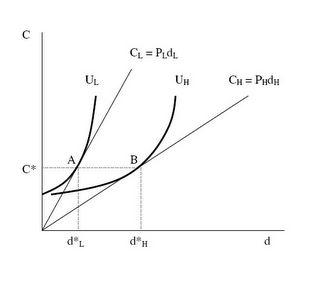
Different?

I recently raised a concern to some collegues. On examining two master's thesis defense, I was surprised by the huge gap of quality between the two. Yet, both passed. Why so? I was told, because one student was from "regular" program, while the other one from "executive" program. "So the executive program should not be as tough as the regular program". Fine. But I was curious: would they hold identical certificate? To my surprise, the answer was: yes.
I usually don't care with how people gets their jobs. If two persons with different quality end up in the same workplace, do the same thing, and get paid the same amount, I say: none of my business.
But this one is a slightly different problem. It involves maintaing the standard quality of our graduates. I would feel bad to let students leave unprepared for job market. In addition, I don't want the market to perceive that we produce graduates with low quality.
It's happening, unfortunately. I hope this is not simply because we desperately need to raise money and have to sacrifice quality.
Thinking about it a little further, this situation is not only harmful to the department/university itself, but also to the students, and to the employers. A prospective student of the regular program would think twice: why should I work harder than some other students, if we would all get exactly the same labels? Below is a brief explanation of the effect to the hiring company (see graph above):
Think about a company seeking for two employees with master’s degree in economics. Assume that two of our graduates fill in the application. The company doesn’t want graduates from other university. Our two graduates hold the same diploma. But their quality differs. Graduate L has low probability (P) of failing his assignment, while H has high probability. Both alumnae’s utility curves are shown accordingly. Note that C is “coverage”, or think about wage; and d is “premium” or, for that matter, effort required from the employee. Don’t over-interpret “effort”. It simply means, “If you are not good enough, then you should work harder to be in par with the other – if you demand equal wage”.
The company system goes like this: the more likely you are to fail your task, the more effort you should undertake, and we will pay you accordingly. Obviously from employee’s point of view, less d and more C is preferable – hence the shape and the direction of the utility curves.
If the company can clearly separate between the “low-risk” and “high-risk” employees, it can require different effort levels. For a given wage level, therefore, the equilibrium is A for the good graduate and B for the worse graduate. However, many times, companies fail to identify which one is which – especially when their diplomas are identical. So, since both types prefer A to B, the former will be chosen by both. In this case, the company will make zero "profit" with L-type and negative profit with H-type. If the company wish to prevent any H-type (whichever graduate it turns out) to move to point A, and therefore implements a single rate (d*LH), it will make profit at the cost of low-risk employees.
On the other hand, the good graduate is surely disadvantaged by the situation. With the same effort level with the worse graduate, but with higher quality, he is underpaid (or put differently, the worse graduate is overpaid).
In plain words: moral hazard is at play. And maybe adverse selection as well.
No comments:
Post a Comment